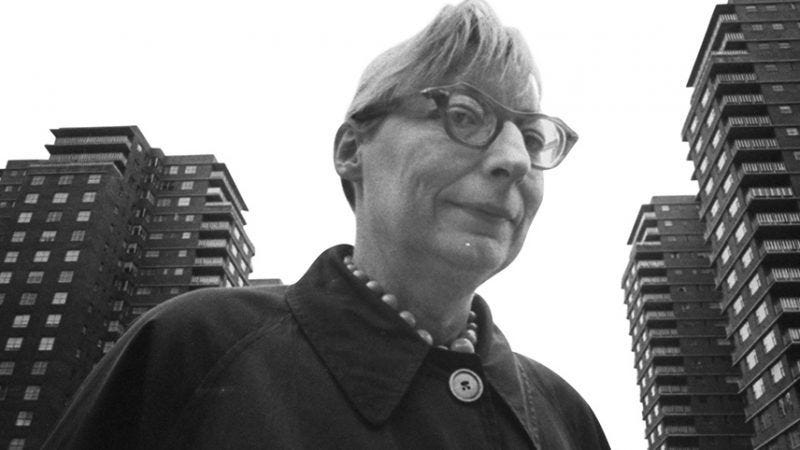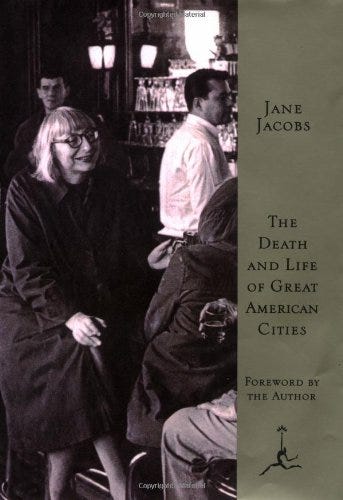

Discover more from Holodoxa
To Build a Healthy Super-Organism: A City for Citizens
My tentative foray into Jane Jacobs' theories of urban life, including her one-woman crusade against "slum clearance" and "urban renewal."
No one is more identified with viewing cities through the collective lives of their citizens than the famous urban writer-theorist Jane Jacobs. Her defining book, The Death and Life of Great American Cities, had an enormous influence across the globe on how we think about cities and how we approach “urban planning.” It’s required reading for anyone interested in cities whether a student, a professional, or just an intellectually curious citizen.
~Geoffrey West in Scale (p.253)
There is a temptation among those with the power to shape the design and infrastructure of a city to impose a rational vision for the lives of the populace. The sensible idea is to create an idyllic space that optimizes form and function, matching demand with supply in a pretty package. This appeals to both business elites and hipster aesthetes. But one upstart journalist couldn’t stand this thoughtless utopianism and its draining unintended consequences.
Jane Jacobs, “St. Jane” as some modern acolytes call her, thought paternalistic ideas about city planning had the whole business of cities backwards. Jacobs, a credential-less autodidact and 1950/60s resident of New York City’s Greenwich Village, conceived of cities as natural entities, super-organisms if you will, comprised of many people with their own agendas, having to compete and cooperate - live - together. Cities couldn’t be rationally imposed by design, the planning needed to be responsive and deferent to the complex networks of the various niches within a city already in place.
And Jacobs was more than a critic of rationalist planning. Her ideas have become foundational to a grassroots, decentralized approach to city development. She offered this striking alternative vision. She advocated and agitated for that vision. She made it a reality. And she wasn’t shy about expressing herself. Here are some examples:
There is no logic that can be superimposed on the city; people make it, and it is to them, not buildings, that we must fit our plans…. We can see what people like.
and
In this dependence on maps as some sort of higher reality, project planners and urban designers assume they can create a promenade simply by mapping one in where they want it, then having it built. But a promenade needs promenaders.
and
The pseudoscience of planning seems almost neurotic in its determination to imitate empiric failures and ignore empiric success.
and
His aim [Ebenezer Howards'] was the creation of self sufficient small towns, really very nice towns if you were docile and had no plans of your own and did not mind spending your life with others with no plans of their own. As in all Utopias, the right to have plans of any significance belonged only to the planner in charge.
As a journalist and activist, working in the mid-to-late 20th century, Jacobs ambitiously and vigorously challenged the orthodoxies of urban planning. This included criticism of the Garden City model popularized by Ebenezer Howard and the Radiant City model pioneered by Le Corbusier. Jacobs seems a bit more hostile to Corbusier's ideas. Her opus, The Death and Life of Great American Cities (1961) contains robust critiques of these approaches and much more. Generally, Jacobs viewed plans that favored large-scale redevelopment, low-density suburbs, segregated land uses, and car-oriented designs as destructive to city vitality. She goes to great lengths in her book to chronicle how these designs destroy the vitality, building diversity, and safety of urban neighborhoods. Some of the ideas are quite surprising like her defense of large sidewalks and her concerns with large, unmonitored parks. Her radically different vision for city life is, evidently to any reader, founded on a wellspring of experiences and keen observations. Her mid-century ideas as detailed in this masterwork of urban theory still have enduring influence today, and, thus, worth exploring.
St. Jane's Critique of "Rationalist" City Planning
The Death and Life of Great American Cities is divided into four parts, each focusing on a different aspect of urban planning and design. In part one, Jacobs introduces her main concepts and principles, such as the need for mixed-use development, short blocks, building diversity (especially aged buildings), and high density to create lively and attractive streets. She also criticizes the conventional measures of city success, such as land values and tax revenues, and proposes alternative criteria, such as the diversity of people and activities, the quality of public space, and the generation of innovation. Her alternative measures of a successful city are somewhat underdeveloped, but are provocative to consider. Her metrics just seem worryingly subjective, difficult to measure and subject to fudging by self-interested local officials. I think in a later book of her she thinks more carefully about city economics.
In part two, Jacobs examines the conditions that foster or hinder city diversity. She identifies four factors that are essential for creating diverse urban environments: (1) primary mixed uses, which ensure that different kinds of people use the same area at different times of the day; (2) small blocks, which allow for more interaction and choice among pedestrians; (3) buildings of various ages and states of repair, which provide a range of rents and opportunities for different kinds of businesses and residents; and (4) concentration of people and buildings, which support a critical mass of economic and social activity. I had little prior awareness of mixed-use development, which is a nice concept that in theory optimizes the distribution of the activity of city dwellers within a limited space. I was also intrigued by the idea of short blocks encouraging more contact in the social space and contributing to increased social capital and distributed surveillance of public spaces. Part two is one of the stronger sections of the work. It is where a lot of the meat of Jacobs’ positive vision for cities is.
In part three, Jacobs discusses the role of public parks and streets in city life. She argues that parks are not automatically beneficial to cities, but rather depend on their location, design, and context. She suggests that parks should be integrated with the surrounding urban fabric, rather than isolated or surrounded by barriers. In the latter situation, parks can become havens of criminal behavior. She also emphasizes the importance of streets as public spaces that facilitate movement, communication, and safety. She advocates for pedestrian-friendly streets that are walkable, interesting, and well-lit, and that facilitate "eyes on the street" - the natural surveillance of residents, shopkeepers, and passers-by. I enjoyed this vision, but I worry there are few places in today’s America with the requisite concentration of social capital for such a communally driven order to emerge. Maybe I’m being too pessimistic or maybe this is in part a failure to heed Jacobs' ideas. But I think it is more a function of the freedom that American society affords (i.e. allowing the revealed preferences for privacy and single family residences to play out) and technological intermediation.
In part four, Jacobs addresses the challenges of governing and planning cities. She warns against the dangers of centralized authority, bureaucratic inertia, and paternalistic interventions that ignore the complexity and diversity of local situations. She calls for more participation and empowerment of grassroots organizations, neighborhoods, and citizens in decision-making processes that affect their lives. She also urges planners to learn from the existing urban reality, rather than imposing abstract models or ideals on it. This was an interesting mixture of small "c" conservative and small "l" liberal notion about city economies. It reminds me a bit of today's eager YIMBY movement but with a touch of more wisdom.
Throughout the book, Jacobs illustrates her arguments with examples from various American cities, especially her home New York City. She draws heavily on her own experience as a resident of Greenwich Village. There she was involved in several campaigns to resist urban renewal projects that threatened to destroy her neighborhood, specifically opposing a Robert Moses led plan to build a four lane highway through Greenwich Village. She writes with passion, humor, and insight, challenging many assumptions and myths about cities and their problems, making for an engaging read. It is not everyday that one cracks open a thoughtful polemic about city design.
Is St. Jane Correct?
Jacobs' ideas are celebrated by many of both political aisles, but she's also been subject to criticism (well after her showdowns with Robert Moses). One of the most frequent criticisms leveled retrospectively, especially from left-leaning activists, is that most of her exemplary areas of urban vitality have now gentrified, pushing out many original residents and homogenizing architecture/infrastructure. I'm not entirely sure this is an accurate criticism. I’m not well informed on the history of these neighborhoods or the current facts and figures. Additionally, I am not entirely sure Jacobs would find gentrification of some of these areas problematic. My guess, based only on my reading of this one book, is that she’d be lukewarm on the contemporary gentrification question, offering a mix of praise and criticism. It would depend entirely on how the gentrification process happened. To me, some of her ideas seem more or less like a celebration of the organic rejuvenation of declining neighborhoods. Her opposition to “urban renewal” is an opposition to misguided planning, not an objection to economic development it.
Other major criticisms of St. Jane are mostly a response from the rationalist camp of planner, especially those with the economic consequences in mind:
Jacobs' emphasis on diversity and density may not be sufficient to explain or promote urban vitality. Other factors such as human capital and potential, geography and climate, income, education, amenities, and public services may also play a role in shaping urban outcomes. (I’m especially sensitive to this critique as there some level of talent and resources required to promote vitality and subdue disorder).
Jacobs' opposition to large-scale planning may overlook the potential benefits of coordinated and comprehensive interventions that address big challenges, e.g. infrastructure. An otherwise, incomplete theory for a thriving city ecosystem due to provincialism (interestingly enough, Jacobs made arguments supporting separatism - see the recommended reading below).
Jacobs' celebration of grassroots participation may neglect the power dynamics and conflicts that exist within and between urban communities. Her understanding of how human interests may intersect and conflict is sometimes overly optimistic or at least overly optimistic about resolving conflicting interests with her preferred solutions.
These criticisms are important but not fatal to most of Jacobs' ideas. She simply presents a lot of ideas, and I think now even six decades later much remains to be tested or tried despite whatever we’ve learned from the available successes and failures. It is obviously difficult to study these questions scientifically. The general nature of the criticisms of Jacobs suggest that her ideas have some amount of indeterminate potential. Their practicality at scale, their unintended consequences, and their relationship with economic realities remains unclear at least to me. Admittedly, this is not an area I'm particularly knowledgeable in.
What mitigates these critiques is that Jacobs was a dynamic and adaptive thinker. I haven't read her other books, but I know she's a fountain of different ideas. She certainly acknowledges that cities are complex and dynamic systems that require constant observation and experimentation. Her different perspective is valuable. Plus, her punchy perspective is not devoid of epistemic humility. In fact, her whole program is staking out the more humble position that city planning must follow the inclinations of its people not mold them. The Death and Life of Great American Cities is just not a strict program for urban planning but a blueprint for future planners to iterate and invent upon. Maybe even mix her grassroots ideas with those of top-down and "rationalist" conceptions.
To many The Death and Life of Great American Cities is still a source of inspiration and provocation for ongoing urban inquiry and action. It is widely regarded as one of the most influential books on urban planning and design ever written. Her ideas have not only inspired generations of planners, architects, activists, scholars, and citizens to rethink their views and practices regarding cities, but also energized a wide-range of different ideas concerning urban environments that can loosely be called "decentralist." The book remains a classic and must-read for anyone interested in cities and their future.
Assorted quotes from The Death and Life of Great American Cities:
"Cities have the capability of providing something for everybody, only because, and only when, they are created by everybody."
"There is no logic that can be superimposed on the city; people make it, and it is to them, not buildings, that we must fit our plans."
"Dull, inert cities, it is true, do contain the seeds of their own destruction and little else. But lively, diverse, intense cities contain the seeds of their own regeneration, with energy enough to carry over for problems and needs outside themselves."
“There is a quality even meaner than outright ugliness or disorder, and this meaner quality is the dishonest mask of pretended order, achieved by ignoring or suppressing the real order that is struggling to exist and to be served.”
“The more successfully a city mingles everyday diversity of uses and users in its everyday streets, the more successfully, casually (and economically) its people thereby enliven and support well-located parks that can thus give back grace and delight to their neighborhoods instead of vacuity. ”
















